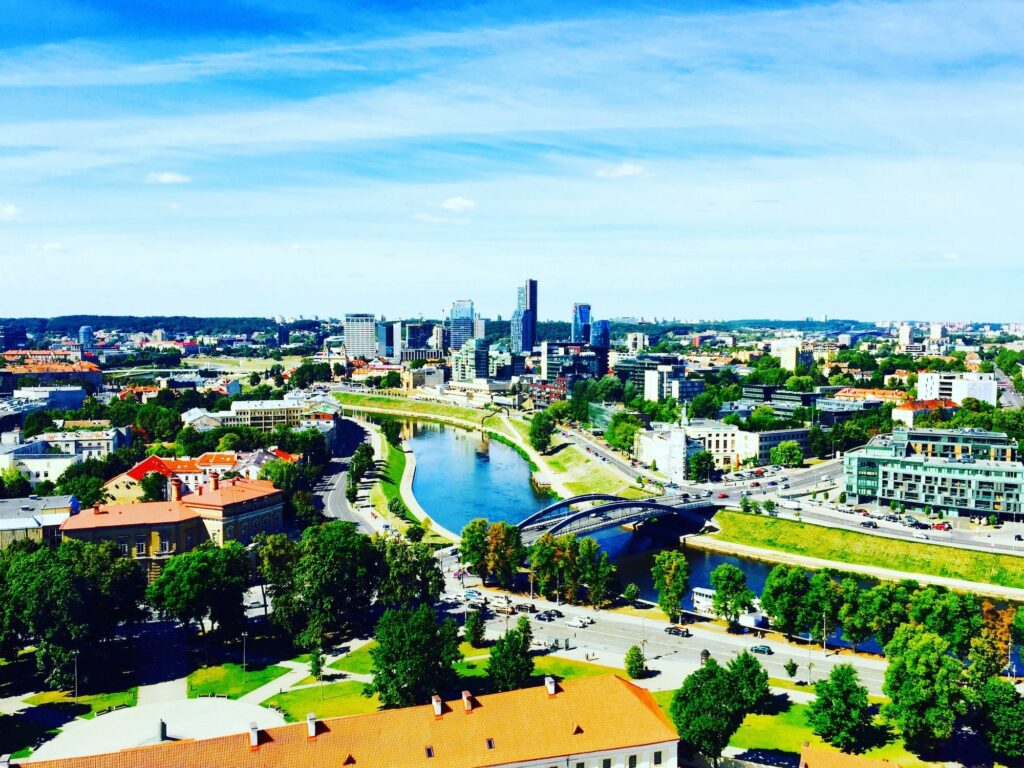The e-Residency program of Lithuania just launched, but it's still in its early alpha stage.

I just became a Lithuanian e-Resident. For those of you who still don’t know about it, Lithuania launched a program similar to Estonian’s digital nation. It was approved on January 2021, but the application process was not open until June 21.
After the pioneering program from Estonia proved to be a very successful idea, other countries started to develop their own programs. Still, no other applicant (Lithuania, Azerbaijan, etc) has come close to Estonia in terms of development, polishment, and possibilities of the e-Residency program. In this post, I analyze the current status of the e-Residency program of Lithuania and its differences with the Estonian one. I also talk about the advantages of running a Lithuanian company through e-Residency.
The e-Residency Program of Estonia is a product, and a damn good one.
For those of you who haven’t hear about the Estonian one either, it’s a program that allows anyone to apply for an official digital identity from the government of Estonia. If granted, this identity (enclosed in an ID with a chip containing a pair of cryptographic keys that univocally represent and identify you) allows you to access the Estonian administration.
Why is that cool, you may ask? Because you can open and run an Estonian company completely online. This is huge in a world that’s become increasingly location-independent. The obvious market is location independent entrepreneurs, digital nomads, and global startups, but since its launch in 2014, it’s been adopted by a much wider audience.
The e-Residency Program of Estonia is an amazing product. It’s not just the fact that you can launch and run a company online, the paperless, bureaucracy-less system, or the simple and transparent legislation. It’s how the Estonian government and the e-Residency team have polished every corner of the program as a commercial product. From the work of the e-Residency team building a community around it and creating a whole ecosystem of business service providers, banking partners, legal firms, etc, to the availability of easy-to-use interfaces in English. From the marketing and promotion to the legislation supporting it, everything is in its right place.
The e-Residency Program of Lithuania
How does the Lithuanian program fare in comparison? Well, it won’t be fair to compare both programs in equal terms. The Lithuanian e-Residency Program has just been launched, while the Estonian one has been running for more than six years. The Estonian government has devoted funding, resources, and appointed a whole team to take care of it.
Still, the Lithuanian government has a lot to do if they want their program to attract foreign business, investment and talent. It’s a promising start, but it’s still in its early alpha stage.
Right now, being a Lithuanian e-Resident won’t allow you to do a lot of stuff. Unlike in Estonia, you cannot open a company in Lithuania as an e-resident right now. This is bound to change in the (close?) future. But for now, the e-resident status will only allow you to log in to the Electronic Government Gateway, log in to the Lithuanian Migration Information System, and sign documents with your e-signature. None of that is especially exciting for the general public.

Differences between both e-Residency programs
Apart from the limited number of possibilities offered to Lithuanian e-residents right now (most relevantly, opening a company will not be possible until 2022 probably), there are some differences between both programs.
First, the collection of the e-Residency ID. While the Estonian program will deliver it to a pick-up location in more than 40 countries, the Lithuanian e-resident ID must be picked up in Lithuania. Starting 2022, service providers will be allowed to deliver it to you, but it’s still not clear how exactly that will work.
Second, the application and pick-up times. The Estonian e-Residency application takes between 3-9 weeks, while the Lithuanian one is faster. The ID card can be picked up as soon as two weeks after being approved, and the approval process is faster too. In 24 hours, I already had my appointment to pick up my e-resident ID. Again, having to physically go to Lithuania is a major hassle.
Finally, even though the e-Residency status is cheaper to obtain in Lithuania (90€ vs around 120€ in Estonia), it only lasts for three years (as opposed to five), which means, it is more expensive in the long run.
Why Lithuania?
Now let me talk a little bit about the Lithuanian business system. Unless you are a strong supporter of the e-Residency concept (such as me) as a first step to develop a global, intranational framework for digital citizenship, you will probably be interested in the e-Residency program as a way of running a global business in Lithuania. So, why would you want to do that?
When I did my research about the e-Residency program of Azerbaijan, I wasn’t sold at all. Apart from the fact that the program seemed to be dead on arrival (broken links for service providers, applications closed, no English translations), there was an important piece of information missing: Why? Why would I want to become an e-resident of Azerbaijan?
There was no indication whatsoever about the business system, taxes, ease of running a business, tax obligations, benefits of running your company in Azerbaijan… Nothing to attract foreign entrepreneurs, business, and investment into the country.
So what about Lithuania? Well, Lithuania is quite different. Even though the information on the e-Residency website (now just a section of the immigration office) is quite scarce, we know one or two things more about Lithuania and why opening a company there can be beneficial for some entrepreneurs.
Advantages of a Lithuanian company
For starters, Lithuania, like Estonia, is part of the EU. That means your company will have access to the European market and may apply for a VAT number. That’s important if you do business in the EEA. Lithuanian VAT is 21%.
But Lithuania has a very interesting fiscal system also. Even though they don’t have 0% corporate income tax on retained and reinvested earnings (like the Estonian system), their corporate income tax is just 15%. Apart from that, companies founded by individuals (e-residents) are exempt from paying corporate income tax during the first year.
Lithuania also has the concept of micro-companies, businesses that are subject to 5% corporate income tax only. A business is considered a micro-company if it has up to 10 employees and up to 300,000€ in annual revenue, and if its members don’t own other EU companies (together, they don’t hold more than 50% of shares from another EU company or are freelancers in other EU member states).
Unlike Estonia, Lithuania has a fintech-friendly legislation and startup ecosystem. It is much easier to run a fintech there, and as proof, there are more than 80 Lithuanian fintech companies offering Lithuanian (LT) IBANs. That’s an important aspect for many Estonian companies that, launched through e-Residency, struggle to find a banking provider offering them an Estonian IBAN. E-residents don’t want to (or simply can’t) justify “a strong connection” to a country they haven’t even visited, having to resort to fintech solutions instead, and that’s why a strong presence of fintech companies offering local IBANs is important.

So, is Lithuania better than Estonia for doing business?
There’s no simple answer to this question. It depends on your goals and the type of business you have in mind. Initially, the Lithuanian corporate income tax of 15% is much better than the Estonian one (20% of gross). However, the exemption on the latter for reinvested or retained profit may be a game-changer for startups, new business models, or small businesses that are still trying to find its position in the market. It may be also advantageous for freelancers or for companies that are focused on growing, don’t have many (Estonian) employees, or don’t distribute vast amounts of dividends.
As an example, a digital nomad offering software development services while traveling through South-East Asia would be better off running her company in Estonia. If that same entrepreneur and another friend managed a software development agency with 3-4 other employees and a yearly income of 250,000€, probably Lithuania would be a better choice. Do your numbers.
If you have a fintech in mind, then Lithuania is definitely the best option. Its legislation is much more favorable to this type of companies, not just because it makes it easy for them to apply for the licenses and get everything up and running soon, but mainly because it lacks some outdated restrictions that the Estonian legislation has in place, which effectively hampers the ability of an Estonian fintech to be competitive.
Global entrepreneurs should approach the Lithuanian project with caution, though. It’s still in its early alpha stage. It does not have the strong community or sound governmental support and resources of the Estonian program, not to mention the e-Marketplace, the wide array of service providers, banking solutions, and online support.
Applying to become an e-Resident of Lithuania
In a future post, I will explain how to apply to become an e-resident of Lithuania.
Conclusion
Lithuania just launched its e-Residency Program, similar to the Estonian one. Even though it’s still in its early alpha stage, and won’t allow you to do much right now, it’s exciting news. Unlike the Azerbaijani one, the Lithuanian offer has the potential of becoming a serious contender in an expanding market of e-nation services.
I recently applied, and got my appointment to pick up my ID card. I am super thrilled to be an early adopter of the program, and I will update the information on this blog as the situation unrolls.




Comments ()